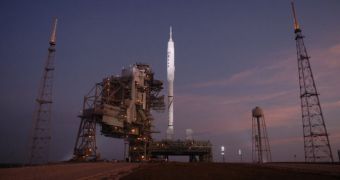After yesterday's weather around the Kennedy Space Center did not allow for the prototype ARES I-X rocket to lift off, mission managers finally got a break in the weather today. Originally planned for 8 am EDT (1200GMT), the first launch of a new NASA rocket in more than 25 years took place at 1130 EDT (1530GMT), in what viewers described as a breathtaking takeoff. The rocket roared through the air in the sound of its massive engines, which sounded a little different from the ones we are accustomed to in the space shuttles.
According to the weather officer at the KSC, the clouds risked inflicting the triboelectrification phenomenon on the suborbital test rocket, so all activities were halted. Pad winds were also above the maximum allowed threshold yesterday, blowing at more than 23 knots below the test rocket. The top acceptable limit was of 20 knots. “We had some opportunities, we just didn't get there – the weather didn't cooperate,” Ed Mango, the ARES I-X launch director, said of the failed launch attempt on Tuesday.
The goal of the flight is to assess the integrity and functionality of the first stage motor, and also to determine if the separation system between the first and second stages is working properly. A number of ground-based systems will also be tested, as well as the operations associated with them. The craft, which is a precursor of the ARES I rocket that will fly the Orion Crew Exploration Vehicle to the low-Earth orbit, is also outfitted with a bogus second stage and payloads, so that the test mimics the actual launch conditions for ARES I as faithfully as possible.
More than 700 sensors aboard the suborbital test spacecraft collected readings during the new test flight. The rocket was made up of two stages. The first one features four live segments and a bogus one, while the second features only dummy payloads that simulate the Orion. If the new prototype rocket had launched yesterday, it would have marked the anniversary of the first Saturn 1 rocket launch, which took place on October 27, 1961, from Pad 34 at the Cape Canaveral Air Force Station.
The test flight itself was fairly simple. The rocket went supersonic within 30 seconds of the launch and then, about 124 seconds into the flight, finished the powered section of the test. Separation between the first stage and the dummy second stage took place shortly after, although it was not immediately clear if the separation occurred precisely the way it was intended. Keep an eye on this space for more details on the new test flight results.

 14 DAY TRIAL //
14 DAY TRIAL //